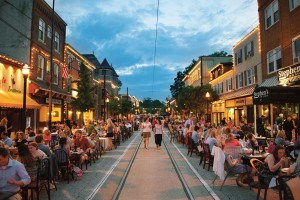Inside the Plan to Bring New Energy to the PECO Power Station on the Waterfront
A long-dormant power station on the Delaware — a tattered icon of our industrial past — is being reborn as luxury apartments. Are we finally figuring out how to embrace, rather than knock down, our architectural heritage?
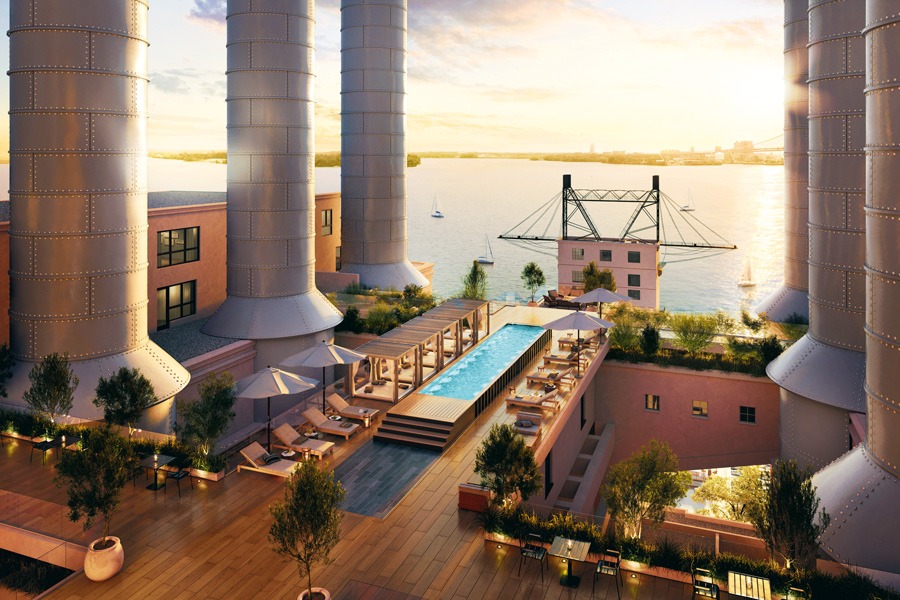
A rendering of the proposed rooftop pool at the Battery. / Courtesy of NQS Creative
They’re keeping the smokestacks.
The eight 167-foot-high chimneys of the former PECO Delaware Generating Station haven’t barfed out noxious exhaust from coal that’s burning to make electricity since the place was switched off around 1975. The stacks have long been a Philadelphia landmark along the Delaware River — originally a statement of power and progress, then a resilient monument to urban decay, burned-out candles on a concrete cake. Now they’re painted up real nice so renters can live amid them.
“They look pret-ty great,” says Kevin Kozlik, director of field operations for the power plant’s redevelopment, as we stand on the roof admiring the workmanship. They’re painted pale gray, not too dark, because there might be plans to dramatically light them at night, but not white, because “we didn’t want it to look like a cruise ship.”
“We had to bring in people who paint bridges,” says Leonard Klehr, who’s with project financier Lubert-Adler. “They were hanging from … ”
“Air-hoist cables,” Kozlik helps.
The power station opened in 1923, maybe two miles from where Ben Franklin first tried downloading electricity for Philadelphia. It soon became the biggest generator of juice for a booming city. In the 1920s, America went from most people not having electricity at home to most people having it. Buildings like this transformed the world. As it turns out, coal-burning over the past century is believed to have been the biggest human contribution to climate change, which, worst-case, could wipe out humanity. A hefty share of that carbon emission came from right here in Fishtown, from this magnificent Beaux Arts building designed by John T. Windrim, the same architect who did the Franklin Institute.
Electricity eventually became a little cleaner, and cheaper to get in other ways. But it took decades of deterioration and graffiti, and the filming of steampunk Bruce Willis scenes for the 12 Monkeys movie, for anybody to figure out what to do with this 223,000-square-foot building. Now, as soon as this summer, it will become luxury apartments with eye-popping city views, co-working and cafe space (smoke-free!), and wedding ballrooms, with picturesque Penn Treaty Park next door and new public access to the riverfront that could eventually include a floating concert barge. So let’s live it up while we can.
The development, christened the Battery, is part of a waterfront revival that over the past decade has reconnected residents to the city’s two rivers, with attractions like Spruce Street Harbor Park, Cherry Street Pier and Schuylkill Banks Boardwalk. It’s also the latest relic of Philly’s more formidable days to get an expensive makeover (projected at $153.6 million) and a new life in a new century.
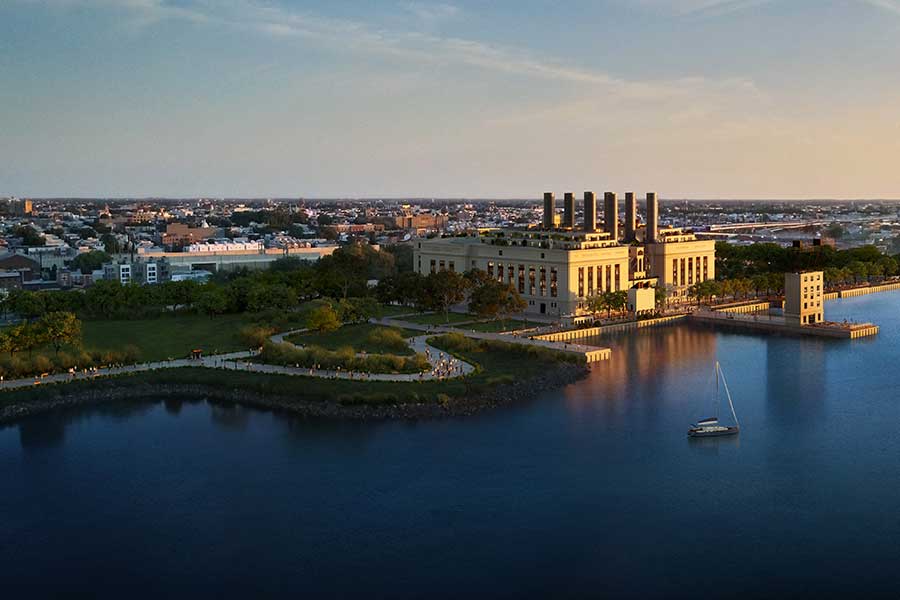
Courtesy of NQS Creative
These days, our culture sometimes seems split between folks eager to obliterate the past in favor of progress and others who imagine making things “great again” by turning the clock backward and retreating to yesterday. Restoration projects like this — and the Divine Lorraine Hotel and Metropolitan Opera House on North Broad Street, South Philly’s Bok Building, the Navy Yard — may imperfectly symbolize a middle ground. They’re ways to revive pieces of the past as part of moving forward. The old days weren’t all roses and chardonnay. There’s plenty we’ve needed to demolish. Coal-burning electric plants, your dirty days are numbered. But these sturdy, pretty buildings still have possibilities.
Leonard Klehr meets me in the parking lot alongside the power plant for my walk-through of the construction. For a while, there was a smaller, secondary generation plant on this lot, but it was ugly and was razed in 2008. Fancy extra buildings may eventually replace these parking spaces if the market stays hot.
Klehr, a Philadelphia attorney, first introduced two of his clients, Ira Lubert and Dean Adler, to each other in 1997. They started Lubert-Adler to manage real estate investment funds, buying, fixing, operating and selling properties for investors. Projects that qualify as historic buildings, like this PECO plant, get a federal tax credit of 20 percent of money spent on restoration — a nice return for Lubert-Adler’s investors even before the building opens for business. Renovated properties also qualify for a 10-year city tax abatement. (This year, the abatement for brand-new construction falls from 10 to five years, potentially incentivizing more adaptive reuses like this.)
In 2006, Klehr resigned from his own law firm to join Lubert-Adler. Now he’s executive vice chairman — and unofficial tour guide. Standing in the parking lot, he waves a hand along the north side of the building.
“This will all be opened up. We’re bringing Palmer Street straight down to the river,” he says.
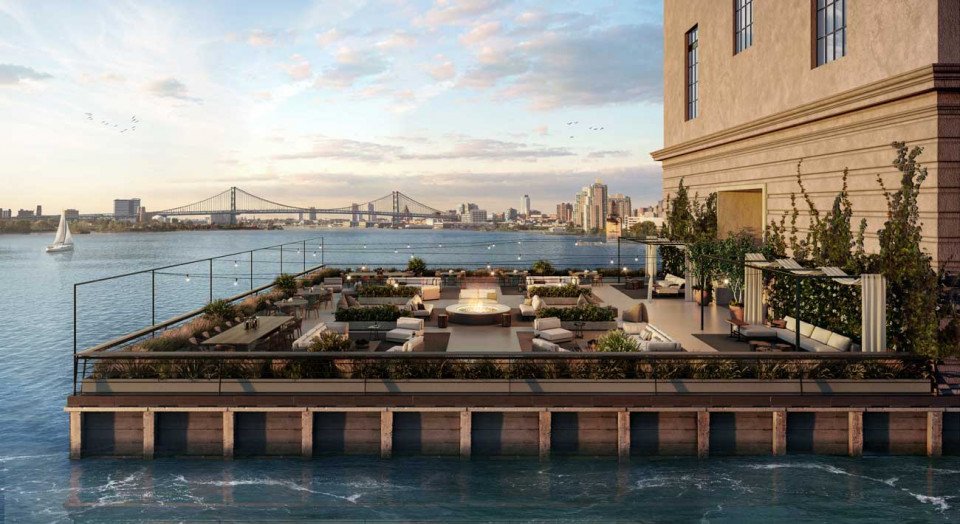
Rendering courtesy of NQS Creative
Well, kind of. This side of the building, historically gated off, will become a public segment of Palmer Street, a landscaped promenade where pedestrians and cyclists can frolic together. Like much of the waterfront, it will still be cut off from the city by Delaware Avenue and I-95. “But there’s been a lot of talk about opening up those streets to allow flow back and forth to the riverfront,” Klehr says hopefully.
We stroll to the city-facing west side of the building. Along Beach Street, there’s a spiky wrought-iron fence to keep people out. “For many years, there was barbed wire on top of it,” Klehr says. “This was a dangerous building, a coal-fired power plant. For 100 years until now, these 11 acres were sealed off.”
We meet up with Kozlik, from general contractor Fastrack Construction, and head to the waterfront side of the building. Jutting into the river here is Pier 61, the coal pier. Barges from Petty’s Island, the company’s primary coal yard, on the Jersey side of the river, would dock here.
“They would clamshell the coal with a crane, put it into a hopper, and it would go into a crusher that would make it the right diameter,” Kozlik explains. Now, the developers might connect the coal pier with a 195-foot floating bandstand designed by Louis I. Kahn, itself a clamshell, that Lubert-Adler bought and needs a place to park.
In the old days, a conveyor belt moved the pulverized coal from the pier to the first section of the plant, the Boiler House, where three-story-high bins dumped it into roaring furnaces that boiled river water into steam. The steam was piped to the middle part of the building, massive Turbine Hall, where it spun rotors inside six long turbines that looked like Harkonnen spaceships from Dune, to create electrical current. The current then passed to the third section, the Switch House along Beach Street, where transformer units resembling long aisles of metal lockers streamed electrons into the city’s wires. The entire building was filled with industrial-era pipes, valves, switches, platforms and gangways, but it also had arched doorways and vaulted ceilings with skylights.
Philadelphia Electric Company built three of these monumental stations along the Delaware. The first and most ornate was down in Chester. It’s beautifully redone as offices now — owned, inhabited and leased by the Philadelphia Union soccer team. This Delaware Generating Station came next. The Richmond station, farther upriver, remains an urban wreck between a city sanitation center and the Betsy Ross Bridge.
In a 2008 exhibition at Philadelphia’s Athenaeum and a 2016 book, photographer Joseph E.B. Elliott and University of Pennsylvania historic preservation and landscape architecture professor Aaron Wunsch called these buildings “Palazzos of Power.” Elliott had won a grant to take pictures inside the buildings, and he told me he encountered the Delaware station “as this kind of lost ruin, like a sort of pyramid in the jungle.”
In fact, the power plants were meant to seem ancient when they were new. The neoclassical Beaux Arts style borrows from Roman, Greek and Renaissance architecture. It’s known for grand scale and flourishes we don’t talk about much anymore, like cornices, quoins and dentils. At a time when the whole idea of an electric company was novel and there was a debate over whether this vital utility should be run privately or by the government, Philadelphia Electric Company used its majestic buildings to pass itself off as a civic institution. These buildings were purposely built to inspire awe from afar, implying both tradition and progress.
“Why the hell does this power plant in this industrial neighborhood look like a Roman bath?” Wunsch asks. “All these big companies wanted to project the image of permanence — that these are institutions you should trust and want to invest in because they are so damn substantial. That tends to play out in classical terms. I consider them artifacts of public relations, actually. You can go back and forth on whether they’re great architecture. But they were meant to have a kind of civic presence, and lo and behold, they kind of do.”
We enter the building, which has been mostly gutted, and head for the money shot, the vast Turbine Hall, its skylights 90 feet above the floor. This is a large room.
“It makes 30th Street Station look puny,” Robert Powers, whose firm wrote the nomination that got the building on the National Register of Historic Places, warned me. Lubert-Adler hasn’t figured out what to do with it yet and is waiting for COVID’s dust to settle to see what people still want to congregate for. “Office space, event space. We think it’ll be market-driven, as opposed to somebody’s dream or vision,” Klehr says. It’s not unusual for adaptive reuse projects with oddball spaces to evolve in phases.
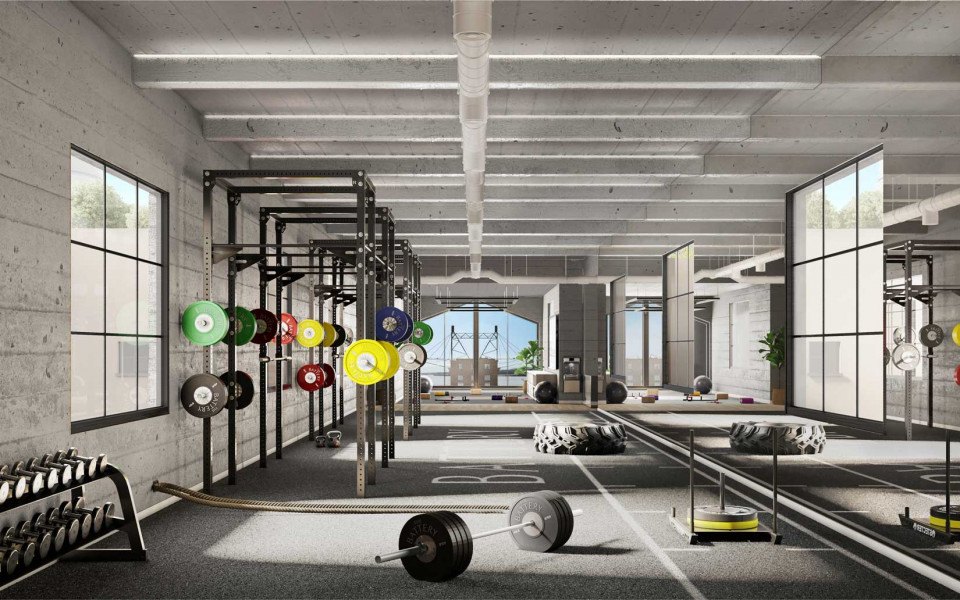
Rendering courtesy of NQS Creative
Developers reimagining turbine halls elsewhere have tried various ideas. In 2000, London’s former Bankside Power Station became the Tate Modern, a gorgeous art museum on the Thames River. Its cavernous turbine hall is for extra-gigantic sculptures. Baltimore’s former Pratt Street Power Plant briefly became an indoor Six Flags amusement park. (Now, it’s a mall.) In Chester, they built a partial mezzanine within the turbine hall, creating a sort of upstairs platform. A software company had offices there but is gone now. It looks like a desolate Grand Central Station inside.
One encouraging sign for our long-term comfort on the planet is just how many of these coal-burning plants are becoming something else. Their closures reflect an evolution in how we extract megawatts from nature, and their reopenings reveal what we want city buildings to do today. The old L Street Power Plant in South Boston is becoming an office/retail complex. The Greenidge power plant in upstate New York now does Bitcoin mining. Even London’s iconic Battersea Power Station, the one on the cover of the 1977 Pink Floyd album Animals with the helium-filled pig, is being prepped for reopening this year as a high-end residential and retail megaplex. Its control room will be a ritzy bar; residents will include Sting, and Apple will have its U.K. campus there, with iPhone-shaped elevators. London has given the building its own tube station. But alas, no dice getting a SEPTA train stop at the restored PECO plant. Klehr says a private shuttle is under discussion.
My guides and I head to the Switch House, the section of the Battery closest to city streets. A long room that once contained transformers will be skylit space for weddings, operated by Joe Volpe’s Cescaphe Event Group.
“All of our venues have been something else in the past,” Volpe tells me later. “Cescaphe Ballroom was an old movie theater. Vie on Broad Street was a car dealer. Tendenza was a brewery. So here was this mysterious, giant building. I fell in love with the scale of it.”
Volpe isn’t merely operating the weddings concession; for a while, he owned the building. He and developer Bart Blatstein bought it from Exelon in 2015, for a reported $3 million. They planned to make it into an event space with restaurants, a banquet hall and guest rooms. Blatstein soon sold his share to Volpe. The big plan didn’t materialize.
“As I started to dig in, I realized it was just out of my league. It was just bigger than me,” Volpe says. He was able to unload the place to Lubert-Adler in 2019 while remaining an investor. The wedding venue will open in the fall, with its own elegant name, to be determined. “Definitely not the Battery,” Volpe says.
There was a time when the transformers here were Philly’s prime electricity source. These days, we’re on a 13-state network called the PJM Interconnection. Our mix of fuel is the same as everybody else’s on this regional grid: at press time, roughly 38 percent natural gas, 33 percent nuclear, 22 percent coal, and six percent renewables.
As part of our planet’s desperate attempt to survive, the City of Philadelphia wants to be carbon-neutral by 2050 and released a Climate Action Playbook in 2021. There will be obstacles. One challenge is that the city owns Philadelphia Gas Works, so it’s launched a study to explore how to achieve carbon neutrality with America’s largest municipally owned natural gas utility. When I speak about this with Christine Knapp, director of the city’s Office of Sustainability, I suggest it’s as if the Eagles decided to become a baseball team but had to keep a lot of the football players.
“Yeah, but then imagine the stadium has to be converted and all the infrastructure has to change, too,” she says.
But electricity is bigger than ever. In the recent book Electrify: An Optimist’s Playbook for Our Clean Energy Future, author Saul Griffith suggests we electrify everything, including heating and vehicles, and move toward 100 percent renewable sources. His energy future involves a lot of high-capacity batteries.
Will this transformed electric plant have batteries? It’s literally called the Battery. I knew the name wasn’t meant to honor Philly sport fans chucking D-cells at J.D. Drew. Historically, buildings called “batteries” along the Delaware River had guns aimed at the British.
“We think it connotes ‘new energy,’” Klehr emails me. “Our premise is that in an ESG world, the preservation of an old building like the Battery is the starting point for sustainability.” I had to google ESG. It stands for “environmental, social and governance” — corporate-citizenship factors that guide some investors. Adaptive reuse for sure is more eco-friendly than raze-and-rebuild, but the Battery isn’t doing anything especially green for its energy. There won’t be solar panels or offshore windmills. “There are no plans to push the envelope. It’s gonna be energy-efficient,” Klehr says.
Finally, our tour hits the Boiler House section on the river, where the deluxe apartments will be. It’s all rentals. The first two floors will accommodate commercial spaces as well as a central area called the Hub, essentially a co-working space. Floors three through eight will be strictly residential. “They’ll have an apartment, and then they’ll have a little space here where they can work on their craft,” Kozlik says.
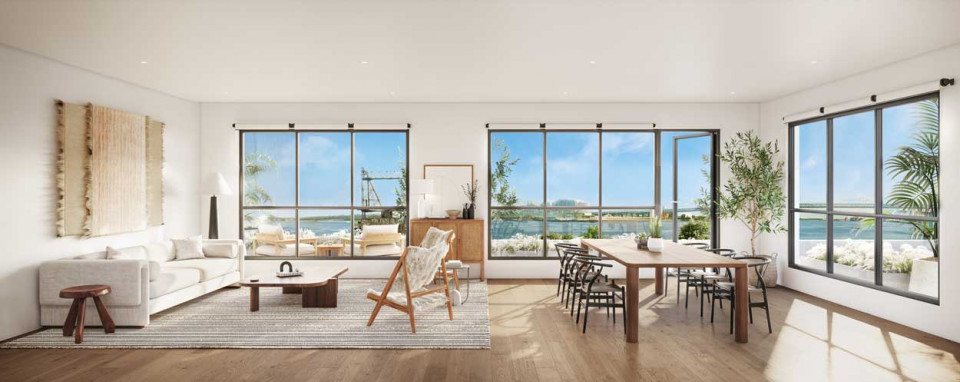
Rendering courtesy of NQS Creative
We climb temporary staircases to higher floors — six stories in the building plus two newly added atop the roof. “We keep going up and it only gets better,” Kozlik says. It really is a million-dollar view from this location, a panorama of the Ben Franklin Bridge spanning the river, then the entire city skyline. The south side overlooks one of the city’s prettiest parks, the legendary spot where William Penn officially grabbed all this land from the Lenape in 1683. As we approach the location of the swanky corner penthouse, Kozlik jokes: “Eleven hundred a month!”
Ha, not likely. Prices aren’t set, but this isn’t an “affordable housing” development. In some ways, the ritzy building will remain as locked away from uninvited guests as when it was swathed in barbed wire. This is land-use change, not social change. But it’s a kind of progress, re-beautifying the sort of post-industrial eyesore the mayor of Detroit recently called “ruin porn.”
“There’s no playbook for this,” Klehr says. “We’ve done adaptive reuse projects — office to apartments, warehouse to apartments, warehouse to office. But this place didn’t have any real estate purpose. This was a machine that they built this beautiful Beaux Arts envelope around.”
“We had to find a purpose for it,” Kozlik says. Of course, in a residential market as hot as today’s, anything can have real estate purpose. Up on top, just outside one of the rooftop apartments, Kozlik points to a doorway-shaped cutout in one of the smokestacks. A floor has been installed in the stack so you can stand inside and see the sky. It’s not a big enough space for somebody to live in, but a renter could go in there to have a beer or grill a burger. Hey, when you want to reuse things that have lost their use, you need to get creative.
“This unit is going to have a walkout patio that’s inside the smokestack,” says Kozlik. “How cool is that?”

Rendering courtesy of NQS Creative
Published as “Electric Avenue” in the April issue of Philadelphia magazine.


